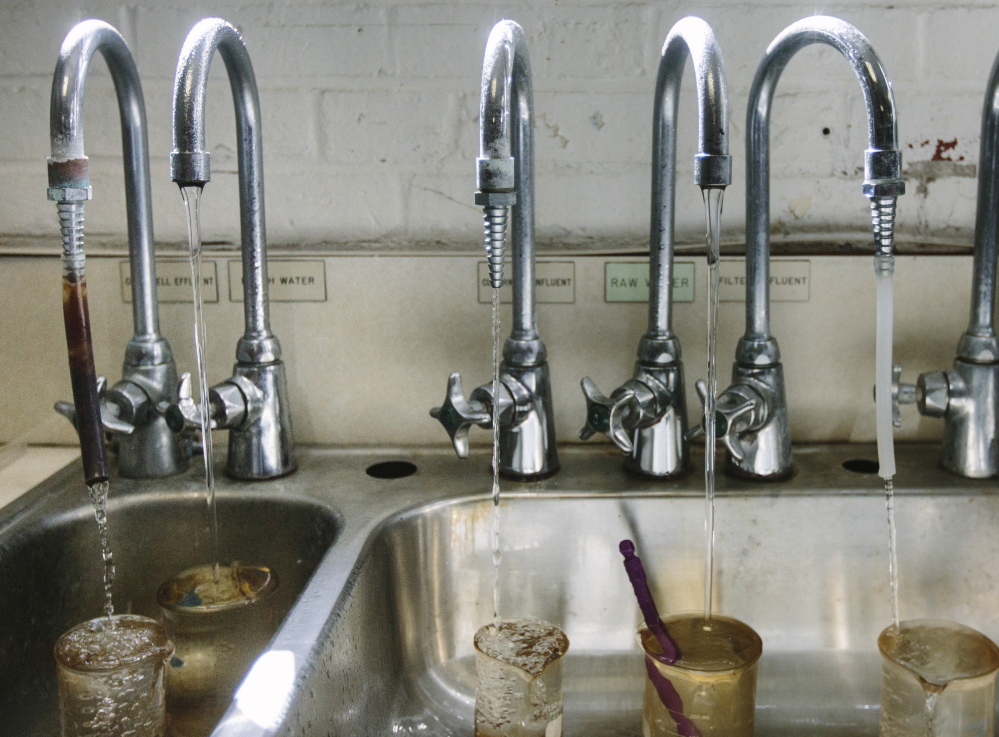The debate over fluoridating public water could re-emerge in Maine in the coming years if a bill before the Legislature is approved.
The bill would make it easier for residents to place measures on the ballot that could result in fluoride being removed from municipal water supplies. The proposal already has drawn opposition from dentists, who say it would jeopardize public health.
Health experts champion the fluoridation of municipal water systems as one of the most important advances in public health of the 20th century, according to the U.S. Centers for Disease Control and Prevention. But putting fluoride in the public water supply has always attracted opposition from people who are uncomfortable with chemicals being added to their water.
The Maine bill came about after a dust-up last year in towns served by the Kennebunk, Kennebunkport and Wells Water District.
About 80 percent of Maine’s public water systems are fluoridated. But because many homes have private wells, only about half the state’s population gets water with added fluoride.
The practice started in Michigan in the 1940s and has spread throughout the country so that roughly 66 percent of the nation’s population now gets fluoridated water, according to the U.S. CDC.
Norm Labbe, superintendent of the Kennebunk, Kennebunkport and Wells Water District, supported an effort by residents in 2014 to place an anti-fluoridation measure on the ballot, and he also backs the current bill before the Legislature.
It would prevent town boards from keeping measures either for or against fluoridation off the ballot, and allow residents to gather petitions to directly put the question to water district customers. Residents who collected petitions representing either 15 percent of a water district’s customers or 1,000 customers could get a fluoridation measure on the ballot.
Labbe, who has worked for public water systems for nearly 40 years, wouldn’t say whether he is anti-fluoride or believes fluoride is dangerous to drink.
“I am not going to answer that question,” Labbe said after a long pause. “I am pro information.”
In 2014, Labbe supported an effort by a handful of residents to put the issue on the ballot in towns served by the water district, but town selectmen refused to do so. The proposed law would take the power to control fluoridation out of the hands of town boards.
Labbe didn’t cite specific studies, but said the science on fluoride is evolving. The American Water Works Association supports fluoridation, but the Maine Water Utilities Association is neutral on the issue.
Despite numerous questions about his views, Labbe declined to wade into the scientific debate.
“That’s not what we do. We’re not the medical people,” said Labbe, who gave the newspaper a tour of the water plant this week. The water district began fluoridating its water in 2003, after voters approved a ballot initiative.
DENTISTS SAY SCIENCE IS WITH THEM
The bill is drawing the ire of dentists, who point to more than 60 years of experience and research that support fluoridation of water as a substantial public health benefit. The research shows that fluoridated water can reduce cavities by about 25 percent, according to the Maine Center for Disease Control and Prevention.
“This is one of the most effective public health tools that we have,” said Dr. Jonathan Shenkin, a Maine dentist who represents the American Dental Association. “You don’t have to be reminded to do anything. If you drink water, it helps prevent tooth decay.”
Shenkin said he is against the bill because it would endanger public health. By making it easier for people to put the issue on the ballot, it could scare people into removing fluoride by promoting false science, he said.
“We shouldn’t risk punishing everyone by letting people campaign with misinformation on fluoride,” Shenkin said. “You should not push your ideology on the rest of society. People already have a choice. They can choose not to drink fluoridated water by buying bottled water or by purchasing a reverse osmosis system (that removes fluoride from tap water).”
Labbe acknowledges that there are many points of view, pro and con, but believes consumers should be in the driver’s seat.
“This empowers the water customers to take a position. We will follow their lead,” he said.
Janice Hanson, the resident who spearheaded anti-fluoride efforts in Kennebunk, told the York County Coast Star in 2014 that fluoride is a “pollutant” in public water systems. When contacted by the Press Herald on Tuesday, she declined to talk about her beliefs on fluoride.
“This is all about letting the people decide,” Hanson said.
The Maine CDC, U.S. CDC, American Medical Association, Environmental Protection Agency and American Dental Association strongly support adding fluoride to water.
Both the U.S. and Maine CDC websites reference numerous studies supporting the practice and say that fluoride in the low concentrations found in public water supplies is completely safe. Most public water systems contain 1 milligram or less of fluoride per liter of water. In Kennebunk it’s 0.7 milligrams, matching the optimal level suggested by the EPA.
FLUORIDE FOUND IN MANY PRODUCTS
A 2008 article in Scientific American questioned whether some populations – especially infants and the elderly – were ingesting too much fluoride because it also is found in many food and beverages, even soda.
Dr. John Doull, professor emeritus of pharmacology and toxicology at the University of Kansas Medical Center, chaired a 2006 National Research Council committee that examined fluoride research, and he told Scientific American that he was concerned about the potential effects of high concentrations of fluoride on the thyroid gland.
Doull also told the magazine he found the research lacking, despite decades of experience.
“We found that many of these questions are unsettled and we have much less information than we should, considering how long this (fluoridation) has been going on. I think that’s why fluoridation is still being challenged so many years after it began,” Doull told the magazine.
Fluoride also occurs naturally, and at high concentrations can cause brittle bones and pitted teeth. Some studies have linked high fluoride levels to intelligence deficits in children. In about 40 percent of private wells tested for fluoride in Maine, concentrations exceeded maximum levels recommended by the EPA.
The U.S. EPA recommends that drinking water contain no more than 2 milligrams of fluoride per liter.
At the Kennebunk water plant, about 0.2 milligrams is naturally occurring, so the water system adds about 0.5 milligrams to make the fluoride match optimum level under EPA guidelines. The water is continuously tested electronically, and is tested manually six times per day.
sPONSOR WANTS TO EXPAND BILL
Rep. H. Stedman Seavey, R-Kennebunkport, one of the sponsors of the bill, declined to give his views on fluoride, but said he believes in giving people a chance to vote on the issue. Seavey wants to revise the bill to make it apply to any issues regarding water districts, not just fluoride.
Hanson said that she and three other people in York County are the bill’s primary supporters. She said they met recently with Seavey and Sen. Ronald Collins, R-Wells, at her home, and persuaded them to sponsor the bill.
Jeff McNelly, executive director of the Maine Water Utilities Association, which represents the state’s water districts, said the association is neutral on the bill and does not participate in fluoride debates. When asked whether he personally believes fluoridated water is safe, McNelly declined to share his views.
“There’s not a ‘Yes, I think fluoride is safe,’ or “No, it’s not.’ It’s not that simple,” McNelly said.
The Maine Municipal Association has not yet taken a position on the bill.
Labbe monitors how much fluoride he drinks because of health concerns. So while he’ll drink some fluoridated water at the plant, he consumes bottled or filtered water at home.
“I limit my intake of fluoride,” Labbe said.
Send questions/comments to the editors.





Comments are no longer available on this story